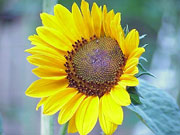This news item expired on Saturday, August 31, 2013 so the information below could be outdated or incorrect.
Don't miss the video link at the bottom of the page!
 Lawns:
Lawns:
-
Late August through September is a good time to seed fescue and bluegrass.
-
Wait until the grass is green to apply the fall fertilizer to the cool season lawn. Fertilizer can be applied starting in late August, but can be done any time through November.
Ornamentals:
-
This is not a good time for general pruning of shrubs. Restrict trimming to removing a few stray shoots. Do not apply nitrogen fertilizer to shrubs.
-
Some plants will bloom until frost if you keep the spent flowers removed. Deadhead butterfly bush, purple coneflowers, phlox, and roses.
-
If you still have hemlock trees in the landscape, check them for signs of hemlock woolly adelgid infestations. Fall is an excellent time to apply soil drench treatments or to spray with insecticidal soap or horticultural oil. More information...
-
To keep those beautiful container gardens going, give them a dose of liquid fertilizer every 2 to 3 weeks.
-
Don’t be afraid to trim plants back if they have gotten leggy.
Fruits:
-
Early apples will be appearing at the Farmers’ Markets. Look for varieties like Gala, Jonagold, Paulared and Granny Smith.
-
Prune blackberries and raspberries after harvest.
-
Fertilize and irrigate the strawberry bed. The plants are forming next spring’s flower buds in September.
-
Peach tree borers can kill peach, cherry and plum trees. To prevent infestation, spray the trunks of the trees in late August and early September with an insecticide labeled for borers (usually a type of pyrethroid). More information...
Vegetables:
-
The biggest challenges with fall vegetables are insect control and watering in August and September. Regular applications of B.t. (Bacillus thuringiensis) will prevent the caterpillars from devouring everything in the cabbage family.
-
Practice good sanitation. Remove spent plants from the garden as soon as harvest is complete. Also remove diseased plants as soon as possible.
-
Harvest basil when the plants begin to flower. Cut stems back to a set of lower leaves to get a flush of new growth.
Other:
-
Check for standing water in plant saucers, clogged gutters and ditches. Dump and refill bird baths weekly. These are typical breeding sites for mosquitoes.
-
While mowing and working in the yard, be alert for yellow jacket nests. Populations that have been docile all summer become very defensive of the nest, and therefore are very aggressive beginning in August. More information...
For more information, view the following video produced by BCTV 2, hosted by Linda Blue, Extension Agent with Buncombe County Cooperative Extension or call 255-5522.
August Garden Chores
Recommendations for the use of chemicals are included in this publication as a convenience to the reader. The use of brand names and any mention or listing of commercial products or services in this publication does not imply endorsement by the North Carolina Cooperative Extension nor discrimination against similar products or services not mentioned. Individuals who use chemicals are responsible for ensuring that the intended use complies with current regulations and conforms to the product label. Be sure to obtain current information about usage and examine a current product label before applying any chemical. For assistance, contact an agent of the North Carolina Cooperative Extension.